Organizational Behavior: Culture, Power, and Motivation
VerifiedAdded on 2023/01/03
|13
|3926
|43
AI Summary
This report explores the importance of organizational behavior in a work environment. It discusses the impact of culture, power, and motivation on the organization. It also covers different cultural models, types of power, theories of motivation, and effective cooperation in teams.
Contribute Materials
Your contribution can guide someone’s learning journey. Share your
documents today.
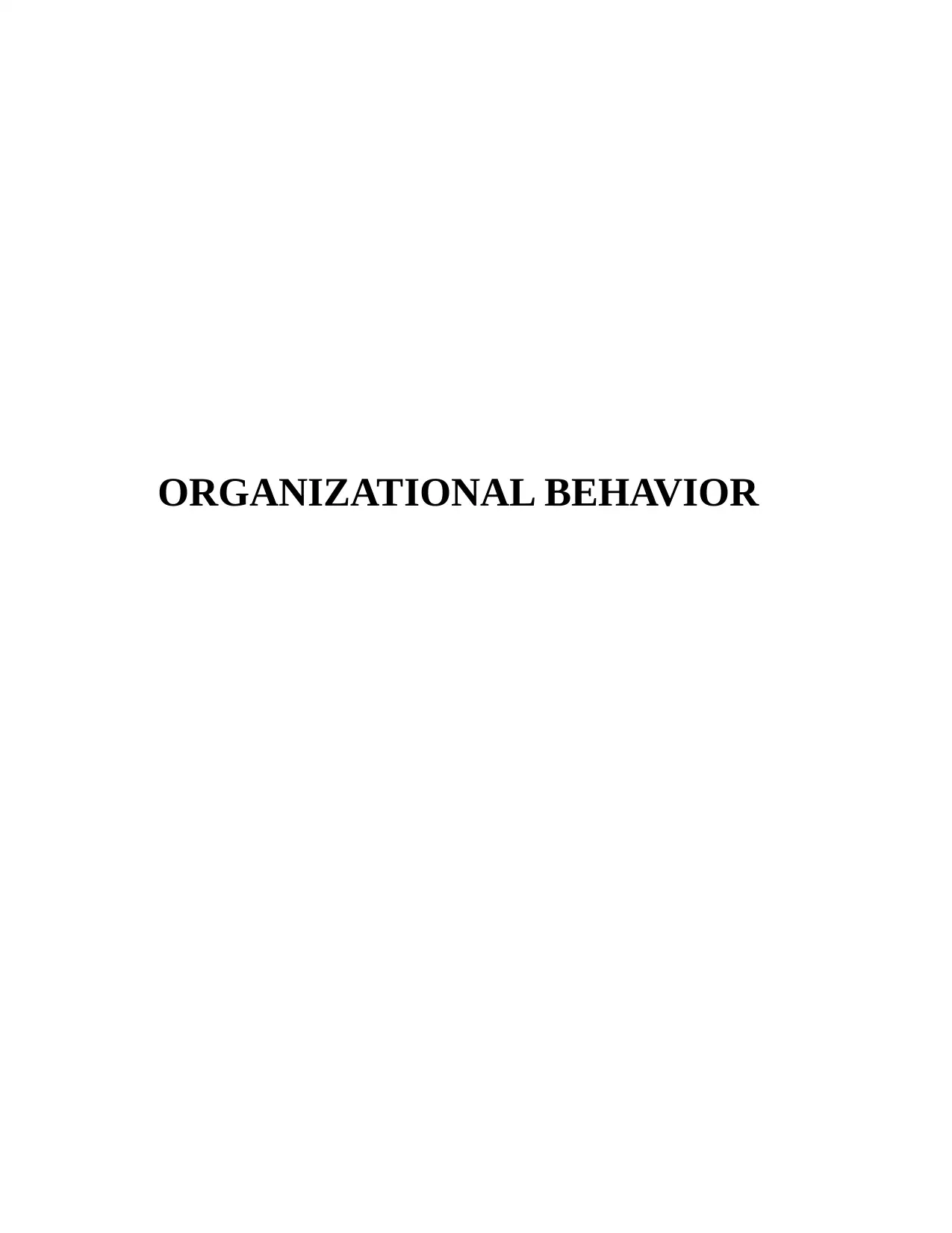
ORGANIZATIONAL BEHAVIOR
Secure Best Marks with AI Grader
Need help grading? Try our AI Grader for instant feedback on your assignments.
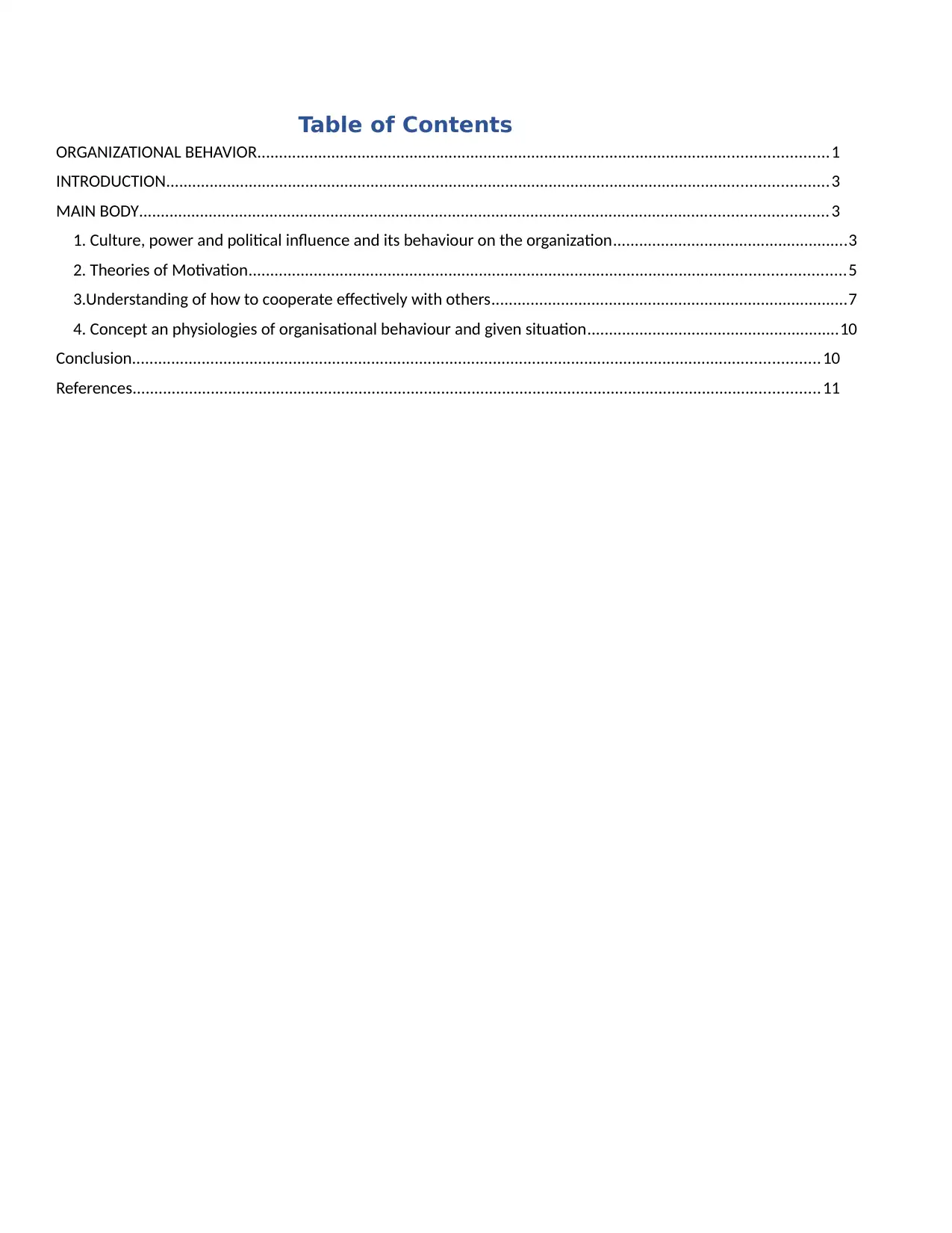
Table of Contents
ORGANIZATIONAL BEHAVIOR...................................................................................................................................1
INTRODUCTION........................................................................................................................................................3
MAIN BODY..............................................................................................................................................................3
1. Culture, power and political influence and its behaviour on the organization......................................................3
2. Theories of Motivation.........................................................................................................................................5
3.Understanding of how to cooperate effectively with others..................................................................................7
4. Concept an physiologies of organisational behaviour and given situation..........................................................10
Conclusion..............................................................................................................................................................10
References..............................................................................................................................................................11
ORGANIZATIONAL BEHAVIOR...................................................................................................................................1
INTRODUCTION........................................................................................................................................................3
MAIN BODY..............................................................................................................................................................3
1. Culture, power and political influence and its behaviour on the organization......................................................3
2. Theories of Motivation.........................................................................................................................................5
3.Understanding of how to cooperate effectively with others..................................................................................7
4. Concept an physiologies of organisational behaviour and given situation..........................................................10
Conclusion..............................................................................................................................................................10
References..............................................................................................................................................................11
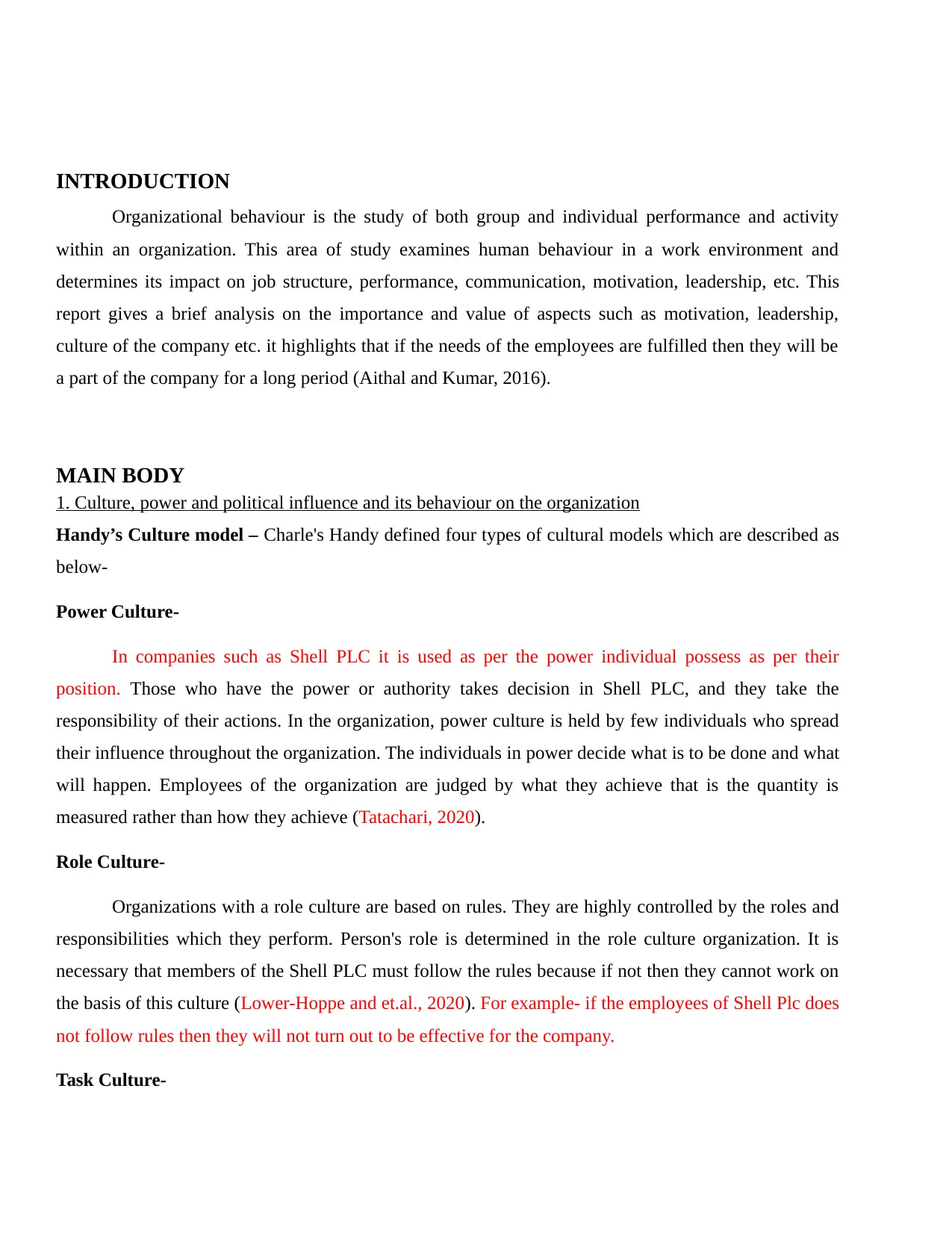
INTRODUCTION
Organizational behaviour is the study of both group and individual performance and activity
within an organization. This area of study examines human behaviour in a work environment and
determines its impact on job structure, performance, communication, motivation, leadership, etc. This
report gives a brief analysis on the importance and value of aspects such as motivation, leadership,
culture of the company etc. it highlights that if the needs of the employees are fulfilled then they will be
a part of the company for a long period (Aithal and Kumar, 2016).
MAIN BODY
1. Culture, power and political influence and its behaviour on the organization
Handy’s Culture model – Charle's Handy defined four types of cultural models which are described as
below-
Power Culture-
In companies such as Shell PLC it is used as per the power individual possess as per their
position. Those who have the power or authority takes decision in Shell PLC, and they take the
responsibility of their actions. In the organization, power culture is held by few individuals who spread
their influence throughout the organization. The individuals in power decide what is to be done and what
will happen. Employees of the organization are judged by what they achieve that is the quantity is
measured rather than how they achieve (Tatachari, 2020).
Role Culture-
Organizations with a role culture are based on rules. They are highly controlled by the roles and
responsibilities which they perform. Person's role is determined in the role culture organization. It is
necessary that members of the Shell PLC must follow the rules because if not then they cannot work on
the basis of this culture (Lower-Hoppe and et.al., 2020). For example- if the employees of Shell Plc does
not follow rules then they will not turn out to be effective for the company.
Task Culture-
Organizational behaviour is the study of both group and individual performance and activity
within an organization. This area of study examines human behaviour in a work environment and
determines its impact on job structure, performance, communication, motivation, leadership, etc. This
report gives a brief analysis on the importance and value of aspects such as motivation, leadership,
culture of the company etc. it highlights that if the needs of the employees are fulfilled then they will be
a part of the company for a long period (Aithal and Kumar, 2016).
MAIN BODY
1. Culture, power and political influence and its behaviour on the organization
Handy’s Culture model – Charle's Handy defined four types of cultural models which are described as
below-
Power Culture-
In companies such as Shell PLC it is used as per the power individual possess as per their
position. Those who have the power or authority takes decision in Shell PLC, and they take the
responsibility of their actions. In the organization, power culture is held by few individuals who spread
their influence throughout the organization. The individuals in power decide what is to be done and what
will happen. Employees of the organization are judged by what they achieve that is the quantity is
measured rather than how they achieve (Tatachari, 2020).
Role Culture-
Organizations with a role culture are based on rules. They are highly controlled by the roles and
responsibilities which they perform. Person's role is determined in the role culture organization. It is
necessary that members of the Shell PLC must follow the rules because if not then they cannot work on
the basis of this culture (Lower-Hoppe and et.al., 2020). For example- if the employees of Shell Plc does
not follow rules then they will not turn out to be effective for the company.
Task Culture-
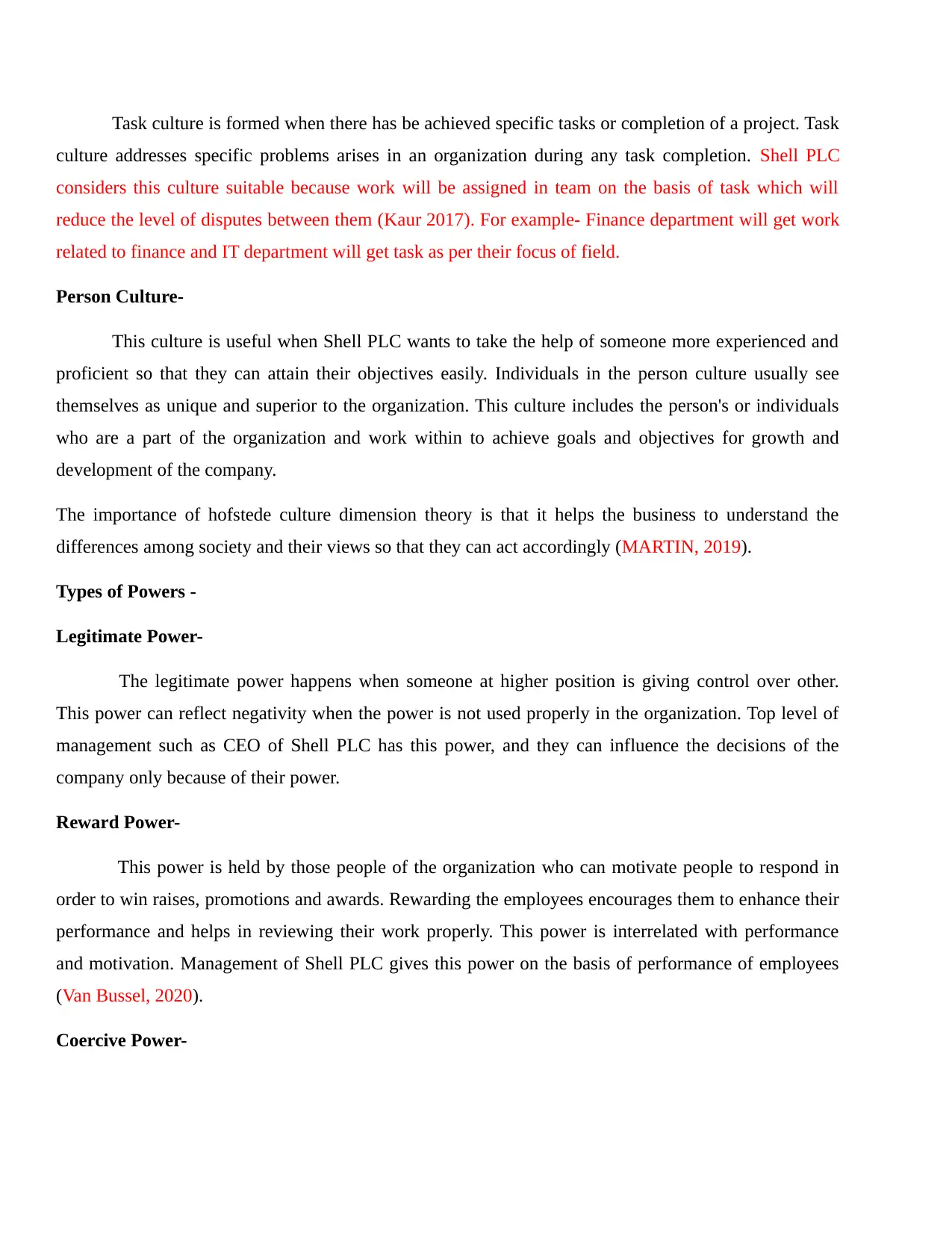
Task culture is formed when there has be achieved specific tasks or completion of a project. Task
culture addresses specific problems arises in an organization during any task completion. Shell PLC
considers this culture suitable because work will be assigned in team on the basis of task which will
reduce the level of disputes between them (Kaur 2017). For example- Finance department will get work
related to finance and IT department will get task as per their focus of field.
Person Culture-
This culture is useful when Shell PLC wants to take the help of someone more experienced and
proficient so that they can attain their objectives easily. Individuals in the person culture usually see
themselves as unique and superior to the organization. This culture includes the person's or individuals
who are a part of the organization and work within to achieve goals and objectives for growth and
development of the company.
The importance of hofstede culture dimension theory is that it helps the business to understand the
differences among society and their views so that they can act accordingly (MARTIN, 2019).
Types of Powers -
Legitimate Power-
The legitimate power happens when someone at higher position is giving control over other.
This power can reflect negativity when the power is not used properly in the organization. Top level of
management such as CEO of Shell PLC has this power, and they can influence the decisions of the
company only because of their power.
Reward Power-
This power is held by those people of the organization who can motivate people to respond in
order to win raises, promotions and awards. Rewarding the employees encourages them to enhance their
performance and helps in reviewing their work properly. This power is interrelated with performance
and motivation. Management of Shell PLC gives this power on the basis of performance of employees
(Van Bussel, 2020).
Coercive Power-
culture addresses specific problems arises in an organization during any task completion. Shell PLC
considers this culture suitable because work will be assigned in team on the basis of task which will
reduce the level of disputes between them (Kaur 2017). For example- Finance department will get work
related to finance and IT department will get task as per their focus of field.
Person Culture-
This culture is useful when Shell PLC wants to take the help of someone more experienced and
proficient so that they can attain their objectives easily. Individuals in the person culture usually see
themselves as unique and superior to the organization. This culture includes the person's or individuals
who are a part of the organization and work within to achieve goals and objectives for growth and
development of the company.
The importance of hofstede culture dimension theory is that it helps the business to understand the
differences among society and their views so that they can act accordingly (MARTIN, 2019).
Types of Powers -
Legitimate Power-
The legitimate power happens when someone at higher position is giving control over other.
This power can reflect negativity when the power is not used properly in the organization. Top level of
management such as CEO of Shell PLC has this power, and they can influence the decisions of the
company only because of their power.
Reward Power-
This power is held by those people of the organization who can motivate people to respond in
order to win raises, promotions and awards. Rewarding the employees encourages them to enhance their
performance and helps in reviewing their work properly. This power is interrelated with performance
and motivation. Management of Shell PLC gives this power on the basis of performance of employees
(Van Bussel, 2020).
Coercive Power-
Secure Best Marks with AI Grader
Need help grading? Try our AI Grader for instant feedback on your assignments.
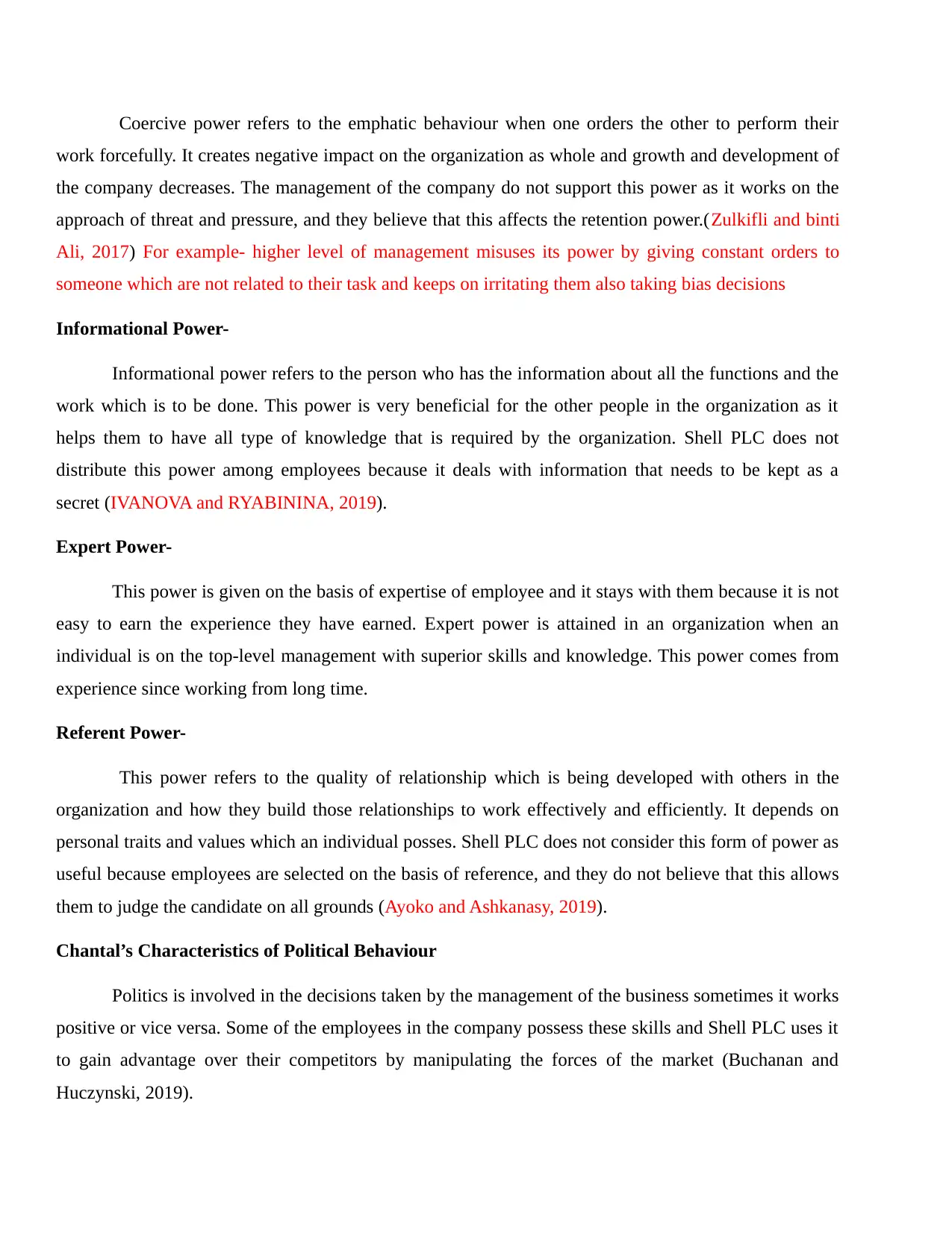
Coercive power refers to the emphatic behaviour when one orders the other to perform their
work forcefully. It creates negative impact on the organization as whole and growth and development of
the company decreases. The management of the company do not support this power as it works on the
approach of threat and pressure, and they believe that this affects the retention power.(Zulkifli and binti
Ali, 2017) For example- higher level of management misuses its power by giving constant orders to
someone which are not related to their task and keeps on irritating them also taking bias decisions
Informational Power-
Informational power refers to the person who has the information about all the functions and the
work which is to be done. This power is very beneficial for the other people in the organization as it
helps them to have all type of knowledge that is required by the organization. Shell PLC does not
distribute this power among employees because it deals with information that needs to be kept as a
secret (IVANOVA and RYABININA, 2019).
Expert Power-
This power is given on the basis of expertise of employee and it stays with them because it is not
easy to earn the experience they have earned. Expert power is attained in an organization when an
individual is on the top-level management with superior skills and knowledge. This power comes from
experience since working from long time.
Referent Power-
This power refers to the quality of relationship which is being developed with others in the
organization and how they build those relationships to work effectively and efficiently. It depends on
personal traits and values which an individual posses. Shell PLC does not consider this form of power as
useful because employees are selected on the basis of reference, and they do not believe that this allows
them to judge the candidate on all grounds (Ayoko and Ashkanasy, 2019).
Chantal’s Characteristics of Political Behaviour
Politics is involved in the decisions taken by the management of the business sometimes it works
positive or vice versa. Some of the employees in the company possess these skills and Shell PLC uses it
to gain advantage over their competitors by manipulating the forces of the market (Buchanan and
Huczynski, 2019).
work forcefully. It creates negative impact on the organization as whole and growth and development of
the company decreases. The management of the company do not support this power as it works on the
approach of threat and pressure, and they believe that this affects the retention power.(Zulkifli and binti
Ali, 2017) For example- higher level of management misuses its power by giving constant orders to
someone which are not related to their task and keeps on irritating them also taking bias decisions
Informational Power-
Informational power refers to the person who has the information about all the functions and the
work which is to be done. This power is very beneficial for the other people in the organization as it
helps them to have all type of knowledge that is required by the organization. Shell PLC does not
distribute this power among employees because it deals with information that needs to be kept as a
secret (IVANOVA and RYABININA, 2019).
Expert Power-
This power is given on the basis of expertise of employee and it stays with them because it is not
easy to earn the experience they have earned. Expert power is attained in an organization when an
individual is on the top-level management with superior skills and knowledge. This power comes from
experience since working from long time.
Referent Power-
This power refers to the quality of relationship which is being developed with others in the
organization and how they build those relationships to work effectively and efficiently. It depends on
personal traits and values which an individual posses. Shell PLC does not consider this form of power as
useful because employees are selected on the basis of reference, and they do not believe that this allows
them to judge the candidate on all grounds (Ayoko and Ashkanasy, 2019).
Chantal’s Characteristics of Political Behaviour
Politics is involved in the decisions taken by the management of the business sometimes it works
positive or vice versa. Some of the employees in the company possess these skills and Shell PLC uses it
to gain advantage over their competitors by manipulating the forces of the market (Buchanan and
Huczynski, 2019).

The rise of globalization and technology has brought changes in the culture as they have made it
more automated and efficient. Less amount of resources are wasted and because of that company is able
to earn more.
2. Theories of Motivation
Extrinsic motivation is concerned with working away from aspects such as threat, pressure and
punishment for the sole purpose of motivation. On the other hand intrinsic motivation involves cases of
employees who works for their own benefit instead of the whole company (Jeanes, 2019).
Content Theory-
Maslow’s Hierarchical Theory-
Physiological Needs-
These are the biological requirements for the human survival such as air, food, shelter etc. If
these needs are not satisfied then the organization fails in the organizational structure formation. This
stage is that where needs arise with basic approach without which one cannot live his or her life. Shell
PLC looks after their loyal employees and has made staff quarters for their homely needs so that they
can stay and eat there.
Safety Needs-
Safety needs become an important part for the employees as they are more concerned about their
safety and security. Employees of the company are scared about their safety as there are many factors for
which they cannot prepare such as natural calamities, war etc. Shell PLC has provided them with
packages that include medical insurance because of which they are less scared about these factors
(Christiana, 2018).
Social Belonging-
People feel that they must have someone with whom they can share their work life as well as
personal life, For example- Shell PLC has allotted staff quarters to their employees so that they can
bond. Other than this they also assign them the work in a team so that they can make their network and
set easily in the company (Dutta and Khatri, 2017).
Self Esteem Needs-
more automated and efficient. Less amount of resources are wasted and because of that company is able
to earn more.
2. Theories of Motivation
Extrinsic motivation is concerned with working away from aspects such as threat, pressure and
punishment for the sole purpose of motivation. On the other hand intrinsic motivation involves cases of
employees who works for their own benefit instead of the whole company (Jeanes, 2019).
Content Theory-
Maslow’s Hierarchical Theory-
Physiological Needs-
These are the biological requirements for the human survival such as air, food, shelter etc. If
these needs are not satisfied then the organization fails in the organizational structure formation. This
stage is that where needs arise with basic approach without which one cannot live his or her life. Shell
PLC looks after their loyal employees and has made staff quarters for their homely needs so that they
can stay and eat there.
Safety Needs-
Safety needs become an important part for the employees as they are more concerned about their
safety and security. Employees of the company are scared about their safety as there are many factors for
which they cannot prepare such as natural calamities, war etc. Shell PLC has provided them with
packages that include medical insurance because of which they are less scared about these factors
(Christiana, 2018).
Social Belonging-
People feel that they must have someone with whom they can share their work life as well as
personal life, For example- Shell PLC has allotted staff quarters to their employees so that they can
bond. Other than this they also assign them the work in a team so that they can make their network and
set easily in the company (Dutta and Khatri, 2017).
Self Esteem Needs-

This is an important need as the employees esteem and their desire of respect from others is
needed. This is the stage of success and with that many people develop ego, status and high standards.
They want that they must get respect and for that management of Shell PLC has formed rules in their
policies that everyone will be treated with respect in the company.
Self Actualization Needs-
These needs are the highest level in Maslow's hierarchy and refers to the realization of a person's
potential and self – growth with development in the organization. This need is the last of all in this
people want to have it all as per their potential and for that board of directors decide who will be the
CEO or some other officer so that their need can be fulfilled.
Process Theory-
Expectancy Theory-
The approach of this theory works on assumptions and expectations through which they try to
reach the goal. They make the expectations on the basis of past results and performance of employees.
(Wilson, 2018) It also states that the behaviour of employees is judged on the basis of the level of
motivation they get.
Instrumentality-
This theory is set on another approach and that is company will set or consider the chance of
giving promotion or increasing their package if they meet the criteria and their expectations (Dutta and
Khatri, 2017).
Valence-
It involves and concerns with value of work. This deals with motivation of employees as it states
more the objectives achieved by the employees more motivated they will be and this will improve their
progress and company will be able to observe better results this way value is added into the work. It
works on different sources of motivation set by the employees which can be fulfilment of needs or
accomplishment of goals (Kondalkar, 2020).
3.Understanding of how to cooperate effectively with others
Collaborative and group working can help SHELL PLC To increase their productivity and
profitability both. it is necessary for the leaders and managers of this company to form a groups and
needed. This is the stage of success and with that many people develop ego, status and high standards.
They want that they must get respect and for that management of Shell PLC has formed rules in their
policies that everyone will be treated with respect in the company.
Self Actualization Needs-
These needs are the highest level in Maslow's hierarchy and refers to the realization of a person's
potential and self – growth with development in the organization. This need is the last of all in this
people want to have it all as per their potential and for that board of directors decide who will be the
CEO or some other officer so that their need can be fulfilled.
Process Theory-
Expectancy Theory-
The approach of this theory works on assumptions and expectations through which they try to
reach the goal. They make the expectations on the basis of past results and performance of employees.
(Wilson, 2018) It also states that the behaviour of employees is judged on the basis of the level of
motivation they get.
Instrumentality-
This theory is set on another approach and that is company will set or consider the chance of
giving promotion or increasing their package if they meet the criteria and their expectations (Dutta and
Khatri, 2017).
Valence-
It involves and concerns with value of work. This deals with motivation of employees as it states
more the objectives achieved by the employees more motivated they will be and this will improve their
progress and company will be able to observe better results this way value is added into the work. It
works on different sources of motivation set by the employees which can be fulfilment of needs or
accomplishment of goals (Kondalkar, 2020).
3.Understanding of how to cooperate effectively with others
Collaborative and group working can help SHELL PLC To increase their productivity and
profitability both. it is necessary for the leaders and managers of this company to form a groups and
Paraphrase This Document
Need a fresh take? Get an instant paraphrase of this document with our AI Paraphraser

make teams effective to achieve the set goals. there are two 2 type of teams formation, firstly effective
and Another one is ineffective.
Different type of organisational team
Project teams
A project team is the team who’s member belong to the various groups and they get a different
functions that are assigned by the project manager (Kabel, C.M. and et.al., 2020). team members can
divided into sub teams according to need and they get a project and they have a equal contribution. For
example - If SHELL PLC Wants to organise an event when they will need help of project management
team where they will initiate, plan, organise and look at the aspects of project so it can be successful
event.
Problem solving team
Problem solving teams are temporary structure that bring lead us together and team members
from across the organisation to focus on solving I specific problem.
Functional team
A functional team is the group of people who are commonly expertize in single
function ,working toward shared objectives.
Impact technology an organisational team
Technology has huge impact on teams within SHELL plc. Technology helps too increase
efficiency and effectiveness of the team member and help them to increase their production and skills
both.
Role of virtual team development and networking
Virtual team has huge contribution in the growth of SHELL plc digitally, a virtual team is
consist of various people that are not located in the same physical location but they are distributed in
various locations through the different geographical areas and they communicate with each other mainly
through information and communication technologies.Virtual teams are part of the IT of the company
who are responsible to show the presence of the company virtually (Oktarina and Fitrawati., 2018). they
work on the technology for example- fax, Emailing and video conferencing services.
and Another one is ineffective.
Different type of organisational team
Project teams
A project team is the team who’s member belong to the various groups and they get a different
functions that are assigned by the project manager (Kabel, C.M. and et.al., 2020). team members can
divided into sub teams according to need and they get a project and they have a equal contribution. For
example - If SHELL PLC Wants to organise an event when they will need help of project management
team where they will initiate, plan, organise and look at the aspects of project so it can be successful
event.
Problem solving team
Problem solving teams are temporary structure that bring lead us together and team members
from across the organisation to focus on solving I specific problem.
Functional team
A functional team is the group of people who are commonly expertize in single
function ,working toward shared objectives.
Impact technology an organisational team
Technology has huge impact on teams within SHELL plc. Technology helps too increase
efficiency and effectiveness of the team member and help them to increase their production and skills
both.
Role of virtual team development and networking
Virtual team has huge contribution in the growth of SHELL plc digitally, a virtual team is
consist of various people that are not located in the same physical location but they are distributed in
various locations through the different geographical areas and they communicate with each other mainly
through information and communication technologies.Virtual teams are part of the IT of the company
who are responsible to show the presence of the company virtually (Oktarina and Fitrawati., 2018). they
work on the technology for example- fax, Emailing and video conferencing services.
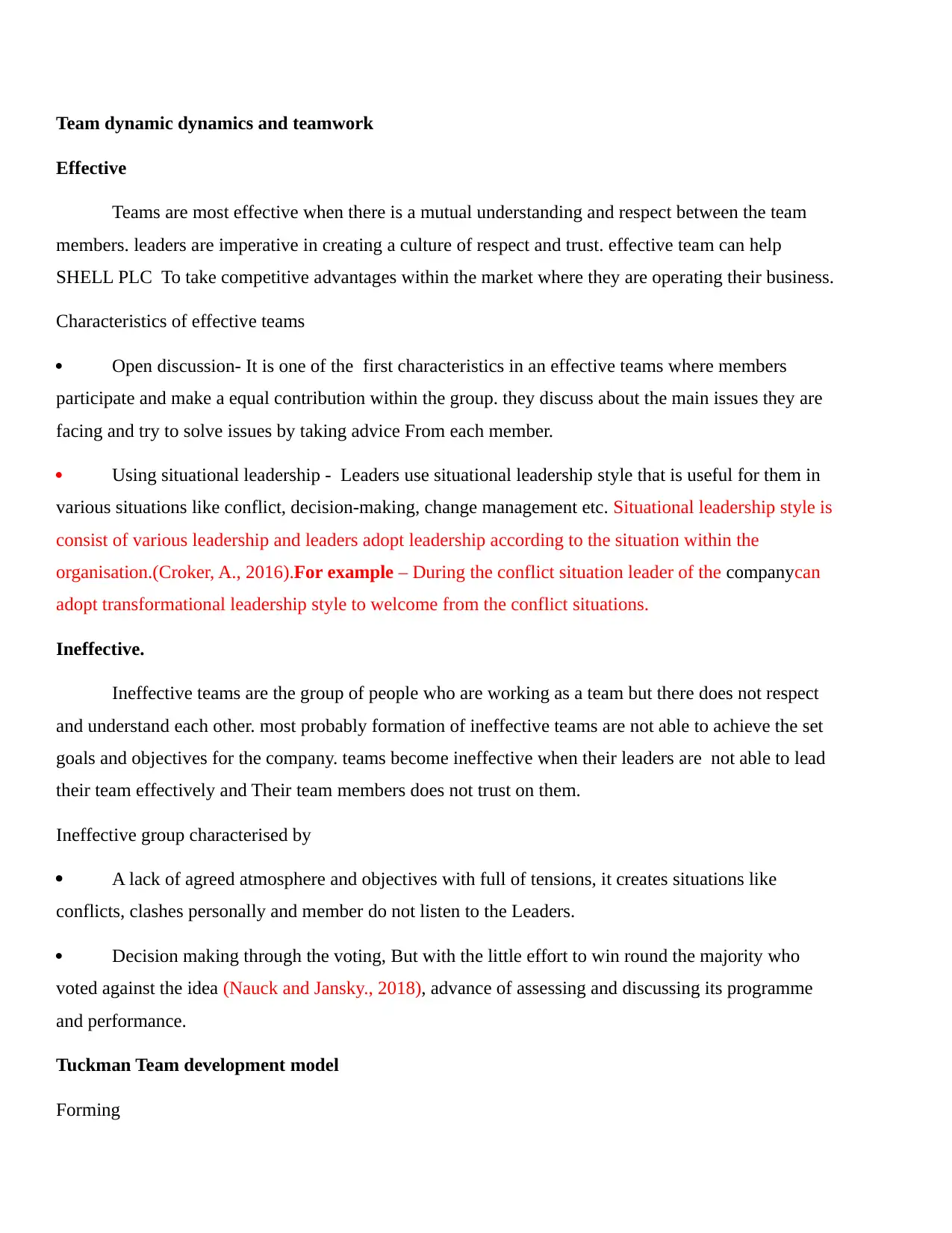
Team dynamic dynamics and teamwork
Effective
Teams are most effective when there is a mutual understanding and respect between the team
members. leaders are imperative in creating a culture of respect and trust. effective team can help
SHELL PLC To take competitive advantages within the market where they are operating their business.
Characteristics of effective teams
Open discussion- It is one of the first characteristics in an effective teams where members
participate and make a equal contribution within the group. they discuss about the main issues they are
facing and try to solve issues by taking advice From each member.
Using situational leadership - Leaders use situational leadership style that is useful for them in
various situations like conflict, decision-making, change management etc. Situational leadership style is
consist of various leadership and leaders adopt leadership according to the situation within the
organisation.(Croker, A., 2016).For example – During the conflict situation leader of the companycan
adopt transformational leadership style to welcome from the conflict situations.
Ineffective.
Ineffective teams are the group of people who are working as a team but there does not respect
and understand each other. most probably formation of ineffective teams are not able to achieve the set
goals and objectives for the company. teams become ineffective when their leaders are not able to lead
their team effectively and Their team members does not trust on them.
Ineffective group characterised by
A lack of agreed atmosphere and objectives with full of tensions, it creates situations like
conflicts, clashes personally and member do not listen to the Leaders.
Decision making through the voting, But with the little effort to win round the majority who
voted against the idea (Nauck and Jansky., 2018), advance of assessing and discussing its programme
and performance.
Tuckman Team development model
Forming
Effective
Teams are most effective when there is a mutual understanding and respect between the team
members. leaders are imperative in creating a culture of respect and trust. effective team can help
SHELL PLC To take competitive advantages within the market where they are operating their business.
Characteristics of effective teams
Open discussion- It is one of the first characteristics in an effective teams where members
participate and make a equal contribution within the group. they discuss about the main issues they are
facing and try to solve issues by taking advice From each member.
Using situational leadership - Leaders use situational leadership style that is useful for them in
various situations like conflict, decision-making, change management etc. Situational leadership style is
consist of various leadership and leaders adopt leadership according to the situation within the
organisation.(Croker, A., 2016).For example – During the conflict situation leader of the companycan
adopt transformational leadership style to welcome from the conflict situations.
Ineffective.
Ineffective teams are the group of people who are working as a team but there does not respect
and understand each other. most probably formation of ineffective teams are not able to achieve the set
goals and objectives for the company. teams become ineffective when their leaders are not able to lead
their team effectively and Their team members does not trust on them.
Ineffective group characterised by
A lack of agreed atmosphere and objectives with full of tensions, it creates situations like
conflicts, clashes personally and member do not listen to the Leaders.
Decision making through the voting, But with the little effort to win round the majority who
voted against the idea (Nauck and Jansky., 2018), advance of assessing and discussing its programme
and performance.
Tuckman Team development model
Forming
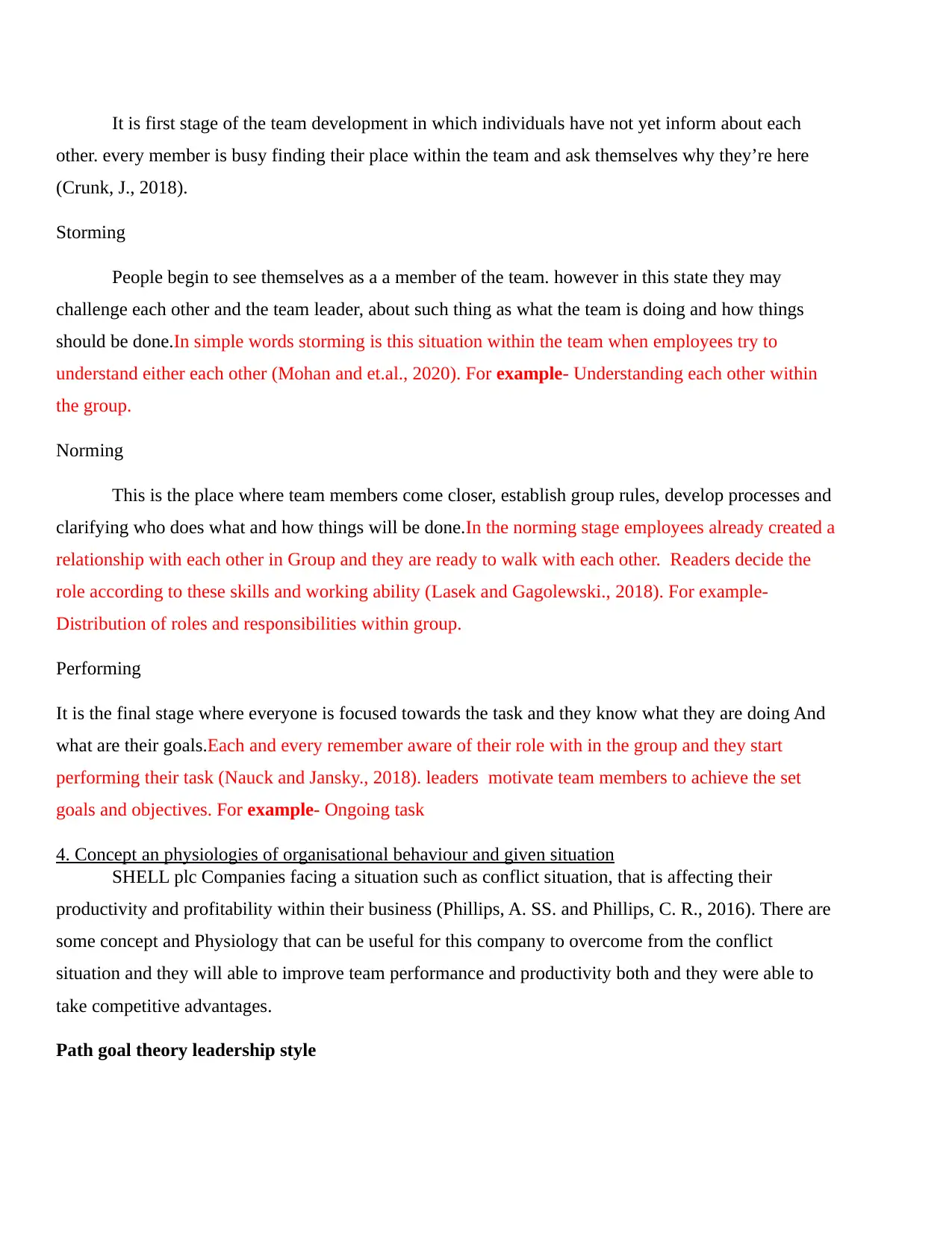
It is first stage of the team development in which individuals have not yet inform about each
other. every member is busy finding their place within the team and ask themselves why they’re here
(Crunk, J., 2018).
Storming
People begin to see themselves as a a member of the team. however in this state they may
challenge each other and the team leader, about such thing as what the team is doing and how things
should be done.In simple words storming is this situation within the team when employees try to
understand either each other (Mohan and et.al., 2020). For example- Understanding each other within
the group.
Norming
This is the place where team members come closer, establish group rules, develop processes and
clarifying who does what and how things will be done.In the norming stage employees already created a
relationship with each other in Group and they are ready to walk with each other. Readers decide the
role according to these skills and working ability (Lasek and Gagolewski., 2018). For example-
Distribution of roles and responsibilities within group.
Performing
It is the final stage where everyone is focused towards the task and they know what they are doing And
what are their goals.Each and every remember aware of their role with in the group and they start
performing their task (Nauck and Jansky., 2018). leaders motivate team members to achieve the set
goals and objectives. For example- Ongoing task
4. Concept an physiologies of organisational behaviour and given situation
SHELL plc Companies facing a situation such as conflict situation, that is affecting their
productivity and profitability within their business (Phillips, A. SS. and Phillips, C. R., 2016). There are
some concept and Physiology that can be useful for this company to overcome from the conflict
situation and they will able to improve team performance and productivity both and they were able to
take competitive advantages.
Path goal theory leadership style
other. every member is busy finding their place within the team and ask themselves why they’re here
(Crunk, J., 2018).
Storming
People begin to see themselves as a a member of the team. however in this state they may
challenge each other and the team leader, about such thing as what the team is doing and how things
should be done.In simple words storming is this situation within the team when employees try to
understand either each other (Mohan and et.al., 2020). For example- Understanding each other within
the group.
Norming
This is the place where team members come closer, establish group rules, develop processes and
clarifying who does what and how things will be done.In the norming stage employees already created a
relationship with each other in Group and they are ready to walk with each other. Readers decide the
role according to these skills and working ability (Lasek and Gagolewski., 2018). For example-
Distribution of roles and responsibilities within group.
Performing
It is the final stage where everyone is focused towards the task and they know what they are doing And
what are their goals.Each and every remember aware of their role with in the group and they start
performing their task (Nauck and Jansky., 2018). leaders motivate team members to achieve the set
goals and objectives. For example- Ongoing task
4. Concept an physiologies of organisational behaviour and given situation
SHELL plc Companies facing a situation such as conflict situation, that is affecting their
productivity and profitability within their business (Phillips, A. SS. and Phillips, C. R., 2016). There are
some concept and Physiology that can be useful for this company to overcome from the conflict
situation and they will able to improve team performance and productivity both and they were able to
take competitive advantages.
Path goal theory leadership style
Secure Best Marks with AI Grader
Need help grading? Try our AI Grader for instant feedback on your assignments.
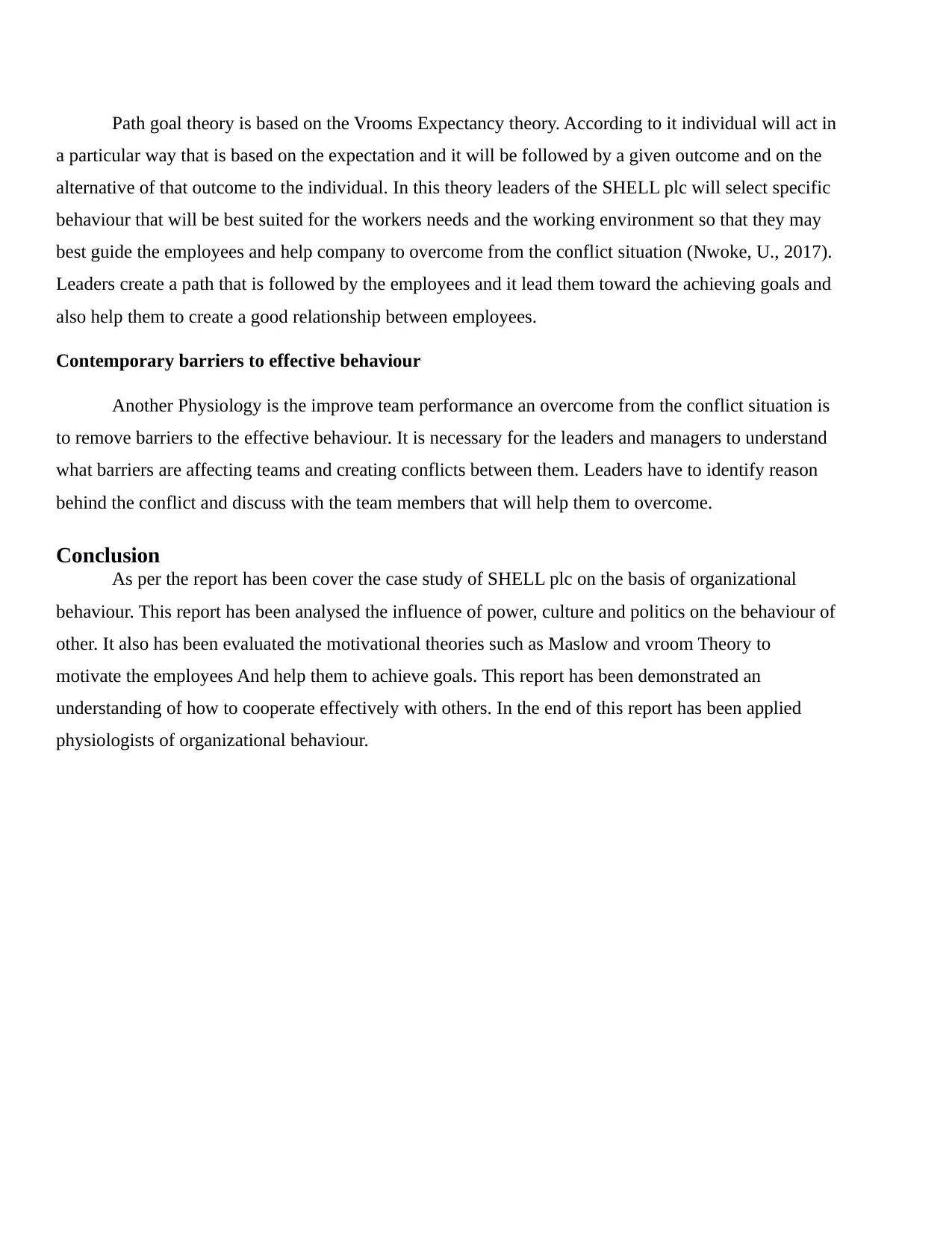
Path goal theory is based on the Vrooms Expectancy theory. According to it individual will act in
a particular way that is based on the expectation and it will be followed by a given outcome and on the
alternative of that outcome to the individual. In this theory leaders of the SHELL plc will select specific
behaviour that will be best suited for the workers needs and the working environment so that they may
best guide the employees and help company to overcome from the conflict situation (Nwoke, U., 2017).
Leaders create a path that is followed by the employees and it lead them toward the achieving goals and
also help them to create a good relationship between employees.
Contemporary barriers to effective behaviour
Another Physiology is the improve team performance an overcome from the conflict situation is
to remove barriers to the effective behaviour. It is necessary for the leaders and managers to understand
what barriers are affecting teams and creating conflicts between them. Leaders have to identify reason
behind the conflict and discuss with the team members that will help them to overcome.
Conclusion
As per the report has been cover the case study of SHELL plc on the basis of organizational
behaviour. This report has been analysed the influence of power, culture and politics on the behaviour of
other. It also has been evaluated the motivational theories such as Maslow and vroom Theory to
motivate the employees And help them to achieve goals. This report has been demonstrated an
understanding of how to cooperate effectively with others. In the end of this report has been applied
physiologists of organizational behaviour.
a particular way that is based on the expectation and it will be followed by a given outcome and on the
alternative of that outcome to the individual. In this theory leaders of the SHELL plc will select specific
behaviour that will be best suited for the workers needs and the working environment so that they may
best guide the employees and help company to overcome from the conflict situation (Nwoke, U., 2017).
Leaders create a path that is followed by the employees and it lead them toward the achieving goals and
also help them to create a good relationship between employees.
Contemporary barriers to effective behaviour
Another Physiology is the improve team performance an overcome from the conflict situation is
to remove barriers to the effective behaviour. It is necessary for the leaders and managers to understand
what barriers are affecting teams and creating conflicts between them. Leaders have to identify reason
behind the conflict and discuss with the team members that will help them to overcome.
Conclusion
As per the report has been cover the case study of SHELL plc on the basis of organizational
behaviour. This report has been analysed the influence of power, culture and politics on the behaviour of
other. It also has been evaluated the motivational theories such as Maslow and vroom Theory to
motivate the employees And help them to achieve goals. This report has been demonstrated an
understanding of how to cooperate effectively with others. In the end of this report has been applied
physiologists of organizational behaviour.
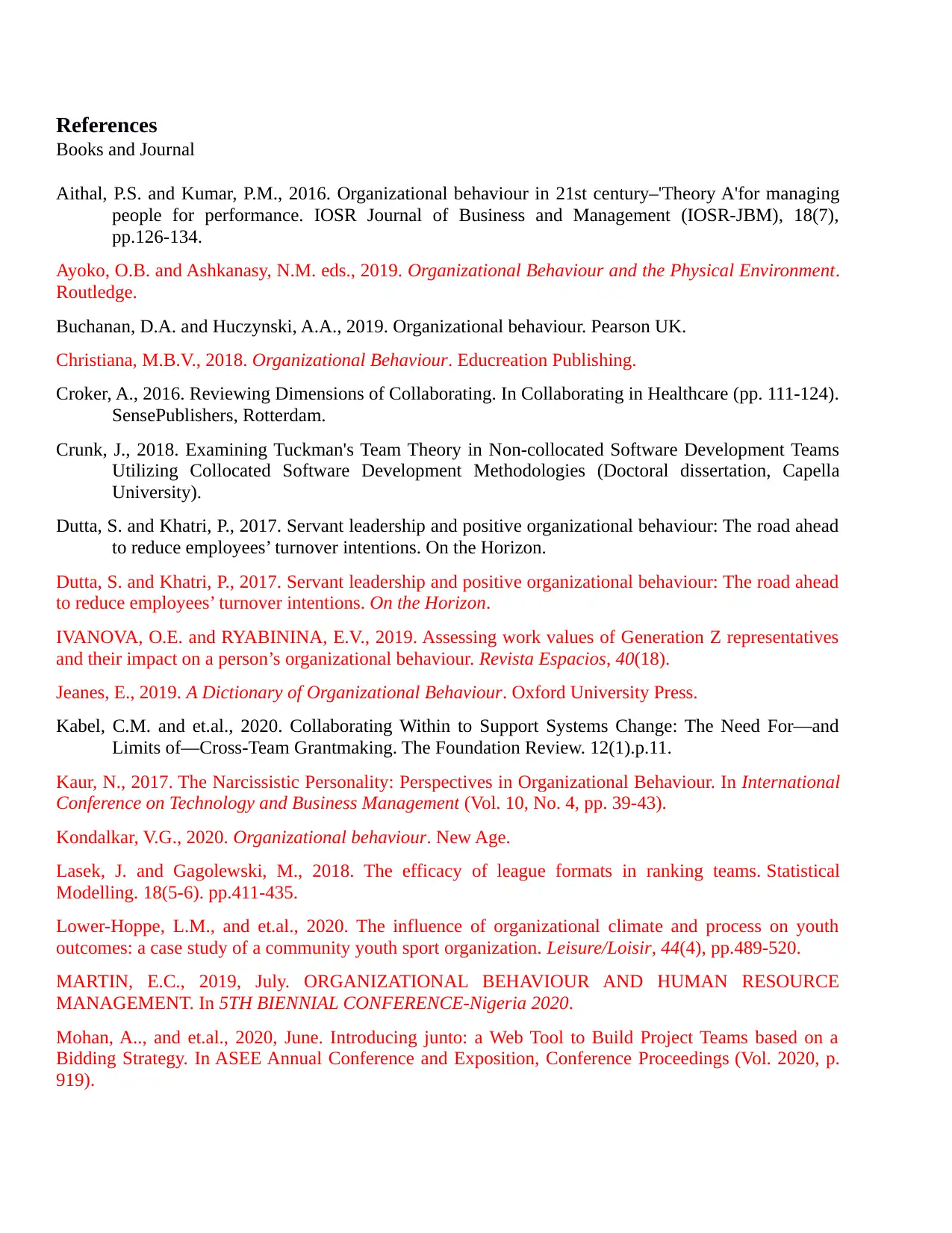
References
Books and Journal
Aithal, P.S. and Kumar, P.M., 2016. Organizational behaviour in 21st century–'Theory A'for managing
people for performance. IOSR Journal of Business and Management (IOSR-JBM), 18(7),
pp.126-134.
Ayoko, O.B. and Ashkanasy, N.M. eds., 2019. Organizational Behaviour and the Physical Environment.
Routledge.
Buchanan, D.A. and Huczynski, A.A., 2019. Organizational behaviour. Pearson UK.
Christiana, M.B.V., 2018. Organizational Behaviour. Educreation Publishing.
Croker, A., 2016. Reviewing Dimensions of Collaborating. In Collaborating in Healthcare (pp. 111-124).
SensePublishers, Rotterdam.
Crunk, J., 2018. Examining Tuckman's Team Theory in Non-collocated Software Development Teams
Utilizing Collocated Software Development Methodologies (Doctoral dissertation, Capella
University).
Dutta, S. and Khatri, P., 2017. Servant leadership and positive organizational behaviour: The road ahead
to reduce employees’ turnover intentions. On the Horizon.
Dutta, S. and Khatri, P., 2017. Servant leadership and positive organizational behaviour: The road ahead
to reduce employees’ turnover intentions. On the Horizon.
IVANOVA, O.E. and RYABININA, E.V., 2019. Assessing work values of Generation Z representatives
and their impact on a person’s organizational behaviour. Revista Espacios, 40(18).
Jeanes, E., 2019. A Dictionary of Organizational Behaviour. Oxford University Press.
Kabel, C.M. and et.al., 2020. Collaborating Within to Support Systems Change: The Need For—and
Limits of—Cross-Team Grantmaking. The Foundation Review. 12(1).p.11.
Kaur, N., 2017. The Narcissistic Personality: Perspectives in Organizational Behaviour. In International
Conference on Technology and Business Management (Vol. 10, No. 4, pp. 39-43).
Kondalkar, V.G., 2020. Organizational behaviour. New Age.
Lasek, J. and Gagolewski, M., 2018. The efficacy of league formats in ranking teams. Statistical
Modelling. 18(5-6). pp.411-435.
Lower-Hoppe, L.M., and et.al., 2020. The influence of organizational climate and process on youth
outcomes: a case study of a community youth sport organization. Leisure/Loisir, 44(4), pp.489-520.
MARTIN, E.C., 2019, July. ORGANIZATIONAL BEHAVIOUR AND HUMAN RESOURCE
MANAGEMENT. In 5TH BIENNIAL CONFERENCE-Nigeria 2020.
Mohan, A.., and et.al., 2020, June. Introducing junto: a Web Tool to Build Project Teams based on a
Bidding Strategy. In ASEE Annual Conference and Exposition, Conference Proceedings (Vol. 2020, p.
919).
Books and Journal
Aithal, P.S. and Kumar, P.M., 2016. Organizational behaviour in 21st century–'Theory A'for managing
people for performance. IOSR Journal of Business and Management (IOSR-JBM), 18(7),
pp.126-134.
Ayoko, O.B. and Ashkanasy, N.M. eds., 2019. Organizational Behaviour and the Physical Environment.
Routledge.
Buchanan, D.A. and Huczynski, A.A., 2019. Organizational behaviour. Pearson UK.
Christiana, M.B.V., 2018. Organizational Behaviour. Educreation Publishing.
Croker, A., 2016. Reviewing Dimensions of Collaborating. In Collaborating in Healthcare (pp. 111-124).
SensePublishers, Rotterdam.
Crunk, J., 2018. Examining Tuckman's Team Theory in Non-collocated Software Development Teams
Utilizing Collocated Software Development Methodologies (Doctoral dissertation, Capella
University).
Dutta, S. and Khatri, P., 2017. Servant leadership and positive organizational behaviour: The road ahead
to reduce employees’ turnover intentions. On the Horizon.
Dutta, S. and Khatri, P., 2017. Servant leadership and positive organizational behaviour: The road ahead
to reduce employees’ turnover intentions. On the Horizon.
IVANOVA, O.E. and RYABININA, E.V., 2019. Assessing work values of Generation Z representatives
and their impact on a person’s organizational behaviour. Revista Espacios, 40(18).
Jeanes, E., 2019. A Dictionary of Organizational Behaviour. Oxford University Press.
Kabel, C.M. and et.al., 2020. Collaborating Within to Support Systems Change: The Need For—and
Limits of—Cross-Team Grantmaking. The Foundation Review. 12(1).p.11.
Kaur, N., 2017. The Narcissistic Personality: Perspectives in Organizational Behaviour. In International
Conference on Technology and Business Management (Vol. 10, No. 4, pp. 39-43).
Kondalkar, V.G., 2020. Organizational behaviour. New Age.
Lasek, J. and Gagolewski, M., 2018. The efficacy of league formats in ranking teams. Statistical
Modelling. 18(5-6). pp.411-435.
Lower-Hoppe, L.M., and et.al., 2020. The influence of organizational climate and process on youth
outcomes: a case study of a community youth sport organization. Leisure/Loisir, 44(4), pp.489-520.
MARTIN, E.C., 2019, July. ORGANIZATIONAL BEHAVIOUR AND HUMAN RESOURCE
MANAGEMENT. In 5TH BIENNIAL CONFERENCE-Nigeria 2020.
Mohan, A.., and et.al., 2020, June. Introducing junto: a Web Tool to Build Project Teams based on a
Bidding Strategy. In ASEE Annual Conference and Exposition, Conference Proceedings (Vol. 2020, p.
919).
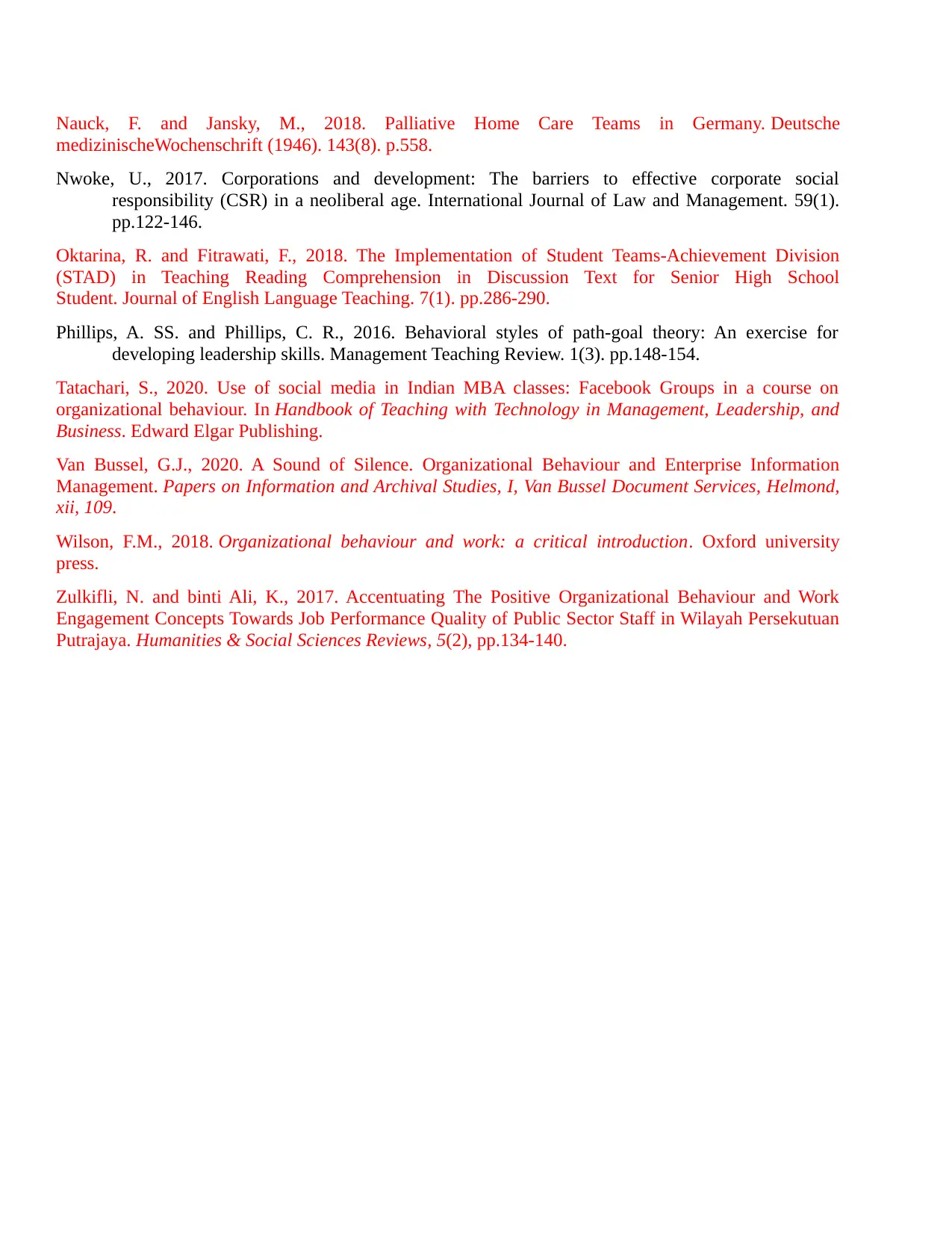
Nauck, F. and Jansky, M., 2018. Palliative Home Care Teams in Germany. Deutsche
medizinischeWochenschrift (1946). 143(8). p.558.
Nwoke, U., 2017. Corporations and development: The barriers to effective corporate social
responsibility (CSR) in a neoliberal age. International Journal of Law and Management. 59(1).
pp.122-146.
Oktarina, R. and Fitrawati, F., 2018. The Implementation of Student Teams-Achievement Division
(STAD) in Teaching Reading Comprehension in Discussion Text for Senior High School
Student. Journal of English Language Teaching. 7(1). pp.286-290.
Phillips, A. SS. and Phillips, C. R., 2016. Behavioral styles of path-goal theory: An exercise for
developing leadership skills. Management Teaching Review. 1(3). pp.148-154.
Tatachari, S., 2020. Use of social media in Indian MBA classes: Facebook Groups in a course on
organizational behaviour. In Handbook of Teaching with Technology in Management, Leadership, and
Business. Edward Elgar Publishing.
Van Bussel, G.J., 2020. A Sound of Silence. Organizational Behaviour and Enterprise Information
Management. Papers on Information and Archival Studies, I, Van Bussel Document Services, Helmond,
xii, 109.
Wilson, F.M., 2018. Organizational behaviour and work: a critical introduction. Oxford university
press.
Zulkifli, N. and binti Ali, K., 2017. Accentuating The Positive Organizational Behaviour and Work
Engagement Concepts Towards Job Performance Quality of Public Sector Staff in Wilayah Persekutuan
Putrajaya. Humanities & Social Sciences Reviews, 5(2), pp.134-140.
medizinischeWochenschrift (1946). 143(8). p.558.
Nwoke, U., 2017. Corporations and development: The barriers to effective corporate social
responsibility (CSR) in a neoliberal age. International Journal of Law and Management. 59(1).
pp.122-146.
Oktarina, R. and Fitrawati, F., 2018. The Implementation of Student Teams-Achievement Division
(STAD) in Teaching Reading Comprehension in Discussion Text for Senior High School
Student. Journal of English Language Teaching. 7(1). pp.286-290.
Phillips, A. SS. and Phillips, C. R., 2016. Behavioral styles of path-goal theory: An exercise for
developing leadership skills. Management Teaching Review. 1(3). pp.148-154.
Tatachari, S., 2020. Use of social media in Indian MBA classes: Facebook Groups in a course on
organizational behaviour. In Handbook of Teaching with Technology in Management, Leadership, and
Business. Edward Elgar Publishing.
Van Bussel, G.J., 2020. A Sound of Silence. Organizational Behaviour and Enterprise Information
Management. Papers on Information and Archival Studies, I, Van Bussel Document Services, Helmond,
xii, 109.
Wilson, F.M., 2018. Organizational behaviour and work: a critical introduction. Oxford university
press.
Zulkifli, N. and binti Ali, K., 2017. Accentuating The Positive Organizational Behaviour and Work
Engagement Concepts Towards Job Performance Quality of Public Sector Staff in Wilayah Persekutuan
Putrajaya. Humanities & Social Sciences Reviews, 5(2), pp.134-140.
1 out of 13
Your All-in-One AI-Powered Toolkit for Academic Success.
+13062052269
info@desklib.com
Available 24*7 on WhatsApp / Email
![[object Object]](/_next/static/media/star-bottom.7253800d.svg)
Unlock your academic potential
© 2024 | Zucol Services PVT LTD | All rights reserved.





